From the Art & Practice draft archives.
Things aren’t always what they seem. So goes the old adage.
The smiling mother chasing her kids in the park may be battling an ugly divorce or struggling with the guilt of a turbid affair. The white picket fence may not display the undercurrent story of addiction that runs through her life’s narrative. The beautiful home across the street provides a shiny façade that hides the modern-day enslavement to an unpleasant job that pays the mortgage.
I’ve come to understand that as a society we value the appearance of things rather than their actual value. We display to the world the happy side of life. We portray to others a sense of perfection and cover up the less-than-desirable aspects of our lives, creating the illusion that our lives are perfect and successful, free of suffering and pain.
One of the criticisms of Facebook and other social media platforms is that they show us nothing but shiny happy people (holding hands), while failing to give a nod to the disease, failure, traffic jams, despair and other unpleasant aspects of real life we all encounter on a daily basis. Though social media, I’ve come to understand, is nothing more than a virtual extension of the society in which we already reside. We no more display these shadow sides to our face-to-face acquaintances than we do to our online ones. It’s simply what we do. We don’t like to show our flaws, even to ourselves.
Peeling the layers off appearances and distilling our desires and goals down to the very essence of our values is challenging. It requires work and attention to mindfulness – waiting for the ripples to settle so that we can see beyond the water’s calm surface. As I practice Mindfulness-Based Stress Reduction exercises I frequently observe my mind visiting the same topics, many of them based on images or how I want others to view me. It reveals to me the extent of which I am shaped by our society, the pressure of the expectations surrounding me and the decisions I make about how I live. It’s a steep learning curve to really understand ourselves, to enter the core of who we really are: what sustains and drives us. It can be painful to examine what our motivations truly are for the actions we take.
Is it important to own a home? What do I really like about the city I live in? What do my purchases say about me as a person? To what extent do they reflect my likes and needs or simply my need to fit in or convey a certain aspect of my personality? I wonder if the need for a certain job, a house or kids form a part of who I am or more about the role I believe I should play in society, or to fulfill the expectations placed upon me.
Getting to the core of life takes effort. It requires practising mindfulness (what does my mind do?), embracing minimalism (what do I really need?), evaluating friendships and expectations (should I branch out more and expand my social circle or invest in the relationships I have with the people who are closest to me?) and plans for the future (where should I live? What is my purpose? What do I want my life to look like?)
One friend, when asked about her plans for the future shrugged her shoulders, explaining that she wasn’t so concerned with what she wanted to do but how she wanted to feel. She cultivated a feeling of positive energy and made decisions that directed her towards that feeling, living in the here and now rather than sacrificing the tangibility of the present for the possibility of a future. Perhaps shutting our eyes and groping around in the dark for a feeling rather than things is key to shaping our lives from the core, removing the layers and biting straight into the sweet juices of the essence of things, rather than being beholden to a pretty, empty shell.
It’s definitely something to meditate on.







